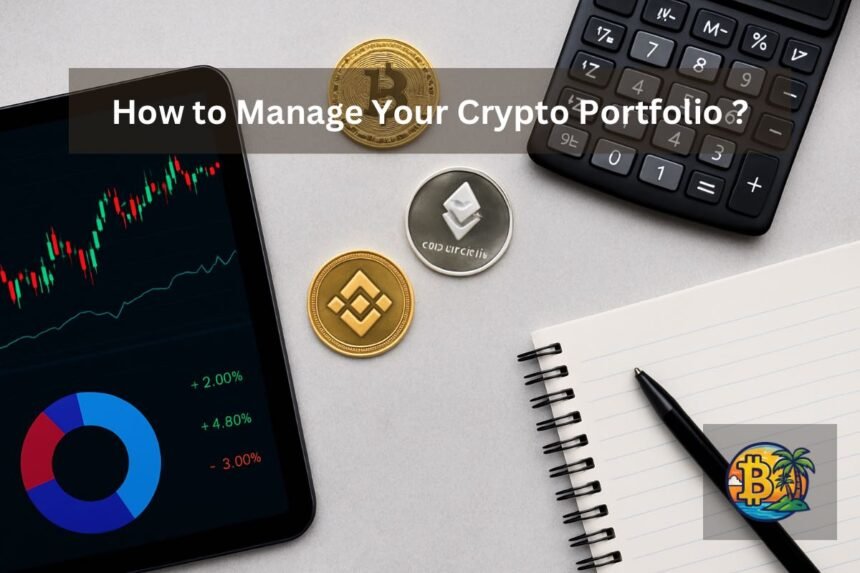Key Insights
- The crypto market is volatile and unpredictable, and it is very easy to fall into emotional decisions or suffer big losses.
- Having a properly managed portfolio reduces emotional trading. When you know what you’re holding and why, you’re less likely to panic or chase pumps.
- Portfolio management helps you to stay calm while others get caught in the chaos.
- Diversification is important in crypto, as it is a great way to reduce risk and build a portfolio that can weather any kind of market condition.
- The more intentional you are, the better your chances of success over the long term.
Managing a crypto portfolio isn’t just for full-time traders. It’s for anyone holding more than one cryptocurrency, whether Bitcoin, altcoins or DeFi yield farming.
Having a plan is important, as it is with everything else in life.
The crypto market is volatile and unpredictable, and it is very easy to fall into emotional decisions, suffer big losses, or miss opportunities if a proper strategy isn’t in place.
This guide is focused on everything you need to know about crypto portfolio management.
From diversification techniques to risk control strategies and helpful tools, you’ll learn how to build a crypto portfolio that’s both strong and profitable.
Why Portfolio Management Is a Must in Crypto?
The crypto market is infamous for making sudden price swings and being unpredictable at times.
One day, Bitcoin could be flying high, and the next, it is down by 20%.
In such an environment, a properly planned portfolio isn’t a luxury; it is a must.
For starters, having a properly managed portfolio reduces emotional trading. When you know what you’re holding and why, you’re less likely to panic-sell or chase pumps.
Managing your portfolio properly helps to protect your capital, as a well-structured portfolio can absorb losses in one area while gains in another keep you in the game.
Finally, portfolio management is the best path towards long-term growth.
By properly managing your portfolio, you aren’t just chasing the next hype cycle. You’re building for the future.
In short, portfolio management helps you to stay calm while others get caught in the chaos.
Diversification and Why It Matters?
Think of diversification as the practice of spreading your investments across different assets.
This strategy is especially important in crypto, as it is a great way to reduce risk and build a portfolio that can weather any kind of market condition.
There are several ways to diversify a portfolio, and here are the most common ones:
1. Diversification By Asset Type
In this kind of strategy, investors don’t put all their money into one token. Instead, they mix major cryptocurrencies like Bitcoin and Ethereum with altcoins like Solana or Avalanche.
They also sometimes include stablecoins like USDC or USDT to give the entire portfolio more stability.
2. By Sector
Crypto isn’t just about coins. It’s an entire ecosystem on its own that contains sectors like DeFi (Uniswap or Aave), NFT & Gaming (projects like Axie Infinity or Immutable), and Infrastructure (networks like Chainlink, Polkadot or Cosmos), among others.
Each sector behaves differently depending on market trends, and spreading across them gives your portfolio more resilience.
3. By Market Cap
Large-cap coins (like BTC and ETH) offer more stability and don’t tend to move around much.
Small- and mid-cap tokens can offer higher growth but are more volatile. Investors sometimes balance between the two based on risk appetite.
Overall, keep in mind that diversification won’t eliminate all risk. However, it will help to make sure that you don’t lose it all from a single bad investment.
Risk Management and Staying Safe
Investing in crypto means accepting some level of risk. However, you can also control how much exposure you take on.
This is where risk management comes in.
1. Understand Your Risk Tolerance
Everyone has a different appetite for risk. Some investors can stomach 30% drops; others start to feel uneasy at 5%.
You must understand how much risk you are willing to take on as a way to guide your portfolio choices. More risk-tolerant investors might prefer to hold altcoins, while conservative investors tend to lean toward Bitcoin and stablecoins.
2. Use Position Sizing
Avoid putting too much into any single asset. No matter how confident you are in a project, limit the percentage of your portfolio allocated to it. This protects you if that asset underperforms or fails.
3. Set Stop-Loss and Take-Profit Orders
Automated trading tools can help you lock in gains or limit losses. For example, a stop-loss can trigger a sale when the price drops to a certain level. Take-profit orders sell your asset once it reaches a present level of gain.
Both tools are great for discipline and keep reducing the need for monitoring the charts 24/7.
4. Avoid Emotion-Based Decisions
Crypto markets are driven by hype, fear and greed, among other emotions. Following the crowd or reacting emotionally to the market rarely ends well.
As such, stick to your strategy, ignore the noise and make decisions based on your long-term goals, not what’s trending on Twitter.
5. Rebalance Regularly
Over time, some assets in your crypto portfolio will grow faster than others. This is where rebalancing comes in.
At regular intervals, adjusting your holdings to realign with your targets can be a good thing.
For instance, if Ethereum outperforms and becomes too dominant, you might sell a portion and reinvest in underweighted areas.
Avoid These Common Mistakes
Even experienced investors can make terrible mistakes, and here are a few common ones to avoid:
The first of these is overinvesting in trends.
Just because a coin is trending doesn’t mean it’s a good investment. Avoid putting too much money into meme coins or hype projects.
Secondly, always check trading fees and whether your chosen asset can be easily sold when needed.
Never enter the market without a clear plan. Define your goals, choose assets accordingly and stick to your plans.
Finally, while spreading risk is smart, holding too many tokens can lead to poor returns.
This tends to make tracking performance difficult, and you should focus more on quality over quantity.
Building for the Long Term
Great crypto portfolio management isn’t about hitting jackpots or chasing the next 100x coin.
It is about being thoughtful and careful with your holdings over time.
Stick to your plan, learn from your mistakes, and use tools to help you stay organized. Most importantly, remember that the crypto market will always be noisy, and your job is to make decisions based on logic, not hype.
Keep learning, adjusting and fine-tuning your crypto portfolio, as the more intentional you are, the better your chances of success over the long term.








